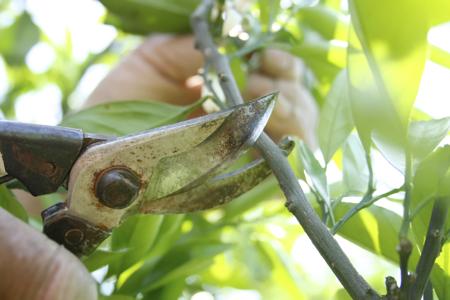Are you growing orange trees and not getting the benefits of your hard work? With our tips on pruning, you'll be growing an orchard in no time.

Fact
The color orange was named after the fruit, and it was used for the first time in the year 1512.Orange trees belong to the same species of citrus. The orange is a hybrid between a pomelo and mandarin. Oranges were introduced to America by Spanish missionaries. It was introduced to Louisiana by French explorers, from where it spread to New Orleans through cutting and grafting of the buds. Oranges were established at every trade port to prevent the spread of scurvy. Different varieties of oranges include common oranges (Valencia, Tiff's Hardiff Valencia and Hamlin), navel oranges, blood oranges, and acid-less oranges.
The orange tree is an evergreen tree, with an average height of 9 to 10 meters, although some grow to the height of 15 meters too. It has oval leaves adorned with long margins. The orange comes in different sizes and shapes, from oblong to spherical. An unripe orange is green in color, and can be ripened using degreening. This only changes the external appearance of the fruit, but cannot ripen it internally.
Talking about the tree, here are step-by-step instructions for pruning orange trees, along with some useful tips.How to Prune an Orange Tree

❑ Any pruning should be done prior to their growth spurt. It is better to have a shorter tree whose fruit you can reach easily, than a large tree spreading its branches. Pruning is done to shape the tree at its earliest stage. Excessive pruning may lead to the tree being vulnerable to disease and rot.
❑ Weak or damaged branches should be pruned immediately. This gives way for new leaves to sprout. The energy once used to support weak branches can be channeled to create better fruit.
❑ Offshoots spring up at unexpected places. They hamper the development of production, and lead to smaller fruit. Pruning shears are perfect for cutting them off.
❑ Thin out the topmost branch of the tree. This is where maximum fruits are produced. Only one-third of the branches should be removed. This allows natural sunlight to filter through and reach the middle branches.
❑ Smaller branches need only one cut, while the larger branches need a minimum of two cuts. Cut the branches two to three inches out from the main trunk to reduce bark damage. Also, cut off any dead branches that arch towards the ground or inward.
❑ Let the tree grow vertically. If any of the branches try to compete with the central branch, trim them immediately.
❑ The best time to prune your orange tree would be from January to March. Pruning should be completed before the leaves blossom. It can be done ever alternate year.
❑ Make sharp cuts so that it won't leave any stub that takes time to heal.
❑ Orange trees produce water sprouts. They may appear as weak branches, which you can brush off easily. But you need to prune the larger ones, as they produce no fruit and leave an opening for disease and pests. Prune them as you would do to a small branch.Tips▷ Use sterilizing alcohol to clean your pruning equipment. This is a preventive measure to protect the tree from diseases.
▷ Do not apply pruning paint on your orange tree. Instead, use a white-washed solution to keep it from burning.
▷ The weather can play spoilsport at times, moody as it is. Spray water on the orange buds to sustain them during humidity.
▷ Water less during the winter and increase the amount by spring.
▷ No trees are devoid of pests. They hide under the stems and leaves, and suck the sap from the fruit. The best way to get rid of them is to wash the leaves and regularly inspect them for bugs.Pruning is essential in the primary years of a tree's life. Keep pruning the stems initially, even if they yield less fruit. It will be beneficial later on, when you get the first taste of a delicious orange.






 FactThe color orange was named after the fruit, and it was used for the first time in the year 1512.Orange trees belong to the same species of citrus. The orange is a hybrid between a pomelo and mandarin. Oranges were introduced to America by Spanish missionaries. It was introduced to Louisiana by French explorers, from where it spread to New Orleans through cutting and grafting of the buds. Oranges were established at every trade port to prevent the spread of scurvy. Different varieties of oranges include common oranges (Valencia, Tiff's Hardiff Valencia and Hamlin), navel oranges, blood oranges, and acid-less oranges.
FactThe color orange was named after the fruit, and it was used for the first time in the year 1512.Orange trees belong to the same species of citrus. The orange is a hybrid between a pomelo and mandarin. Oranges were introduced to America by Spanish missionaries. It was introduced to Louisiana by French explorers, from where it spread to New Orleans through cutting and grafting of the buds. Oranges were established at every trade port to prevent the spread of scurvy. Different varieties of oranges include common oranges (Valencia, Tiff's Hardiff Valencia and Hamlin), navel oranges, blood oranges, and acid-less oranges. ❑ Any pruning should be done prior to their growth spurt. It is better to have a shorter tree whose fruit you can reach easily, than a large tree spreading its branches. Pruning is done to shape the tree at its earliest stage. Excessive pruning may lead to the tree being vulnerable to disease and rot.
❑ Any pruning should be done prior to their growth spurt. It is better to have a shorter tree whose fruit you can reach easily, than a large tree spreading its branches. Pruning is done to shape the tree at its earliest stage. Excessive pruning may lead to the tree being vulnerable to disease and rot.